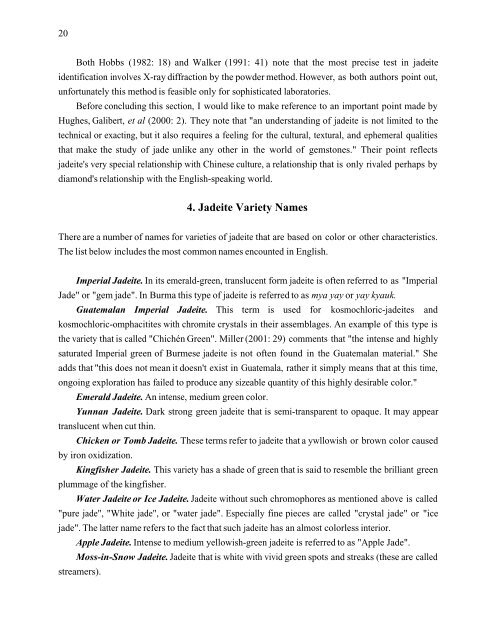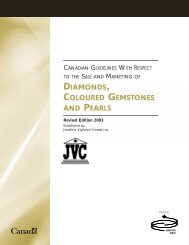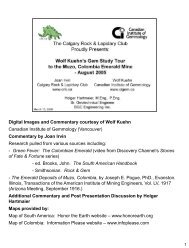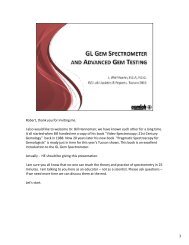JADEITE - Canadian Institute of Gemmology
JADEITE - Canadian Institute of Gemmology
JADEITE - Canadian Institute of Gemmology
You also want an ePaper? Increase the reach of your titles
YUMPU automatically turns print PDFs into web optimized ePapers that Google loves.
20<br />
Both Hobbs (1982: 18) and Walker (1991: 41) note that the most precise test in jadeite<br />
identification involves X-ray diffraction by the powder method. However, as both authors point out,<br />
unfortunately this method is feasible only for sophisticated laboratories.<br />
Before concluding this section, I would like to make reference to an important point made by<br />
Hughes, Galibert, et al (2000: 2). They note that "an understanding <strong>of</strong> jadeite is not limited to the<br />
technical or exacting, but it also requires a feeling for the cultural, textural, and ephemeral qualities<br />
that make the study <strong>of</strong> jade unlike any other in the world <strong>of</strong> gemstones." Their point reflects<br />
jadeite's very special relationship with Chinese culture, a relationship that is only rivaled perhaps by<br />
diamond's relationship with the English-speaking world.<br />
4. Jadeite Variety Names<br />
There are a number <strong>of</strong> names for varieties <strong>of</strong> jadeite that are based on color or other characteristics.<br />
The list below includes the most common names encounted in English.<br />
Imperial Jadeite. In its emerald-green, translucent form jadeite is <strong>of</strong>ten referred to as "Imperial<br />
Jade" or "gem jade". In Burma this type <strong>of</strong> jadeite is referred to as mya yay or yay kyauk.<br />
Guatemalan Imperial Jadeite. This term is used for kosmochloric-jadeites and<br />
kosmochloric-omphacitites with chromite crystals in their assemblages. An example <strong>of</strong> this type is<br />
the variety that is called "Chichén Green". Miller (2001: 29) comments that "the intense and highly<br />
saturated Imperial green <strong>of</strong> Burmese jadeite is not <strong>of</strong>ten found in the Guatemalan material." She<br />
adds that "this does not mean it doesn't exist in Guatemala, rather it simply means that at this time,<br />
ongoing exploration has failed to produce any sizeable quantity <strong>of</strong> this highly desirable color."<br />
Emerald Jadeite. An intense, medium green color.<br />
Yunnan Jadeite. Dark strong green jadeite that is semi-transparent to opaque. It may appear<br />
translucent when cut thin.<br />
Chicken or Tomb Jadeite. These terms refer to jadeite that a ywllowish or brown color caused<br />
by iron oxidization.<br />
Kingfisher Jadeite. This variety has a shade <strong>of</strong> green that is said to resemble the brilliant green<br />
plummage <strong>of</strong> the kingfisher.<br />
Water Jadeite or Ice Jadeite. Jadeite without such chromophores as mentioned above is called<br />
"pure jade", "White jade", or "water jade". Especially fine pieces are called "crystal jade" or "ice<br />
jade". The latter name refers to the fact that such jadeite has an almost colorless interior.<br />
Apple Jadeite. Intense to medium yellowish-green jadeite is referred to as "Apple Jade".<br />
Moss-in-Snow Jadeite. Jadeite that is white with vivid green spots and streaks (these are called<br />
streamers).









